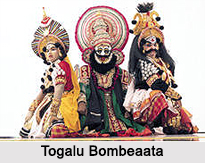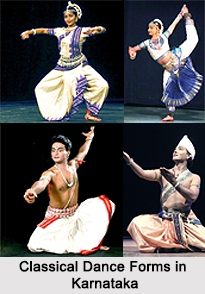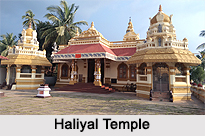 Karnataka has a rich heritage of art and culture. From time immemorial, this place has been the origin and the culmination ground of Indian classical music and other form of arts. Folk culture has its roots in this state and the art forms have heavily borrowed from them. By utilizing the medium of performing arts artistes, convey the various traditions and customs of a particular community. Stories from epics are also portrayed on stage. The performances are eye candy because of the vibrant costumes and make up. Narrators are an indispensable part of these performances. Performing arts have always been a medium to educate people. Through these art forms twin purpose of education and entertainment was achieved.
Karnataka has a rich heritage of art and culture. From time immemorial, this place has been the origin and the culmination ground of Indian classical music and other form of arts. Folk culture has its roots in this state and the art forms have heavily borrowed from them. By utilizing the medium of performing arts artistes, convey the various traditions and customs of a particular community. Stories from epics are also portrayed on stage. The performances are eye candy because of the vibrant costumes and make up. Narrators are an indispensable part of these performances. Performing arts have always been a medium to educate people. Through these art forms twin purpose of education and entertainment was achieved.
Yakshagana
Yakshagana is one of those art forms that is rooted in mythologies. In Hindu mythology, Yakshas are depicted as demi gods who attend to Kubera. This dance drama elaborately portrays the stories from holy texts. A trip to coastal Karnataka is incomplete without watching Yakshagana. Uttara Kannada District, Shimoga District, Udupi District, Dakshina Kannada District are the places where this dance drama is performed. Yakshagana is a unique combination of dance, drama, dialogues, songs, music and resplendent costumes. This dance drama is performed in open-air theatres where audiences are seated on three sides of the stage.
Togalu Bombeaata
Togalu Bombeaata is a puppet show that is quite popular in Karnataka. In this ancient art form, leather puppets are used to enact popular scenes from epics such as Ramayana and Mahabharata. In a world where puppet shows are fast disappearing this age old art form is quite popular in this Indian state. Such shows were performed to ward off the evil powers that bring diseases, epidemics and destroyed crops.
Bhootha Aradhane
 Bhootha Aradhane is a ritualistic dance in Karnataka. The origin of this art form can be traced to the coastal parts of Karnataka and Kerala. This is a way of Tulu worship. This form of folk dance is unique to Karnataka. Bhootha in India refers to ghost. The references to these creatures are found in legends and myths. These creatures are Lord Shiva`s attendants and known as Bhuta Ganas. Bhootha Aradhane is an extension of this worship.
Bhootha Aradhane is a ritualistic dance in Karnataka. The origin of this art form can be traced to the coastal parts of Karnataka and Kerala. This is a way of Tulu worship. This form of folk dance is unique to Karnataka. Bhootha in India refers to ghost. The references to these creatures are found in legends and myths. These creatures are Lord Shiva`s attendants and known as Bhuta Ganas. Bhootha Aradhane is an extension of this worship.
Nagamandala
Snakes have always mystified people. In India snake is seen to accompany Lord Shiva and is thus considered holy enough to worship. Nagamandala is a folk art of worshipping snakes and is prevalent in Dakshina Kannada and Udupi. The beats and movements of the dance are quite attention grabbing. While worshipping the serpent the dance to depict the slithering movement of the snake. This exotic performance is a treat to watch as the dancers are dressed up like serpents. Fear and ignorance about snakes also play a major part in their worship.
Classical Dance Forms in Karnataka
There are various forms of dances in Karnataka. Bharatanatyam (Mysore), Kuchipudi etc are the main classical dances here. Most of these dances are still learnt by people with great zest. All these dances have different music, beat, movements, themes and costumes. Some of the biggest names in Indian dance hail from these schools of dancing.
Krishna Parijatha
Krishna Parijatha is a folk theatre that illustrates the legends revolving around Lord Krishna and Lord Indra. However, there are many theories connected to Krishna Parijatha but the most popular one is that of Krishna waging war over Indra. The two lords fell out over Parijatha tree that came out of the ocean of existence. The entire chain of events is performed through this dance drama.
Dollu Kunitha
This is a drum dance that is quite popular in Karnataka. Dollu Kunitha is accompanied by singing. Men of the shepherd community, Kuruba, perform this. Strong acrobatic movements, drumming and synchronization are the features of this performing art. Other than this, there is another ritualistic dance called the Puja Kunitha. Only instruments accompany very few dances. Puja Kunitha is, thus, unique in its own way.
Shree Ramaseva Mandali
Shree Ramaseva Mandali is an organization that arranges for musical concerts every year. Founded by S.V. Narayanaswamy Rao some 60 years back it diligently organizes this program on classical music. The main feature of this music fest is that new singers are given opportunity to perform along stalwarts. This is held in Bangalore, Karnataka. The biggest names in the Indian music industry perform at this fest arranged by Shree Ramaseva Mandali.
Music in Karnataka
Carnatic music has its origin in Karnataka. Music in Karnataka initially flourished because of the royal patronages. With the coming of different rulers, came their culture. At this point of time influences of other cultures led to the formation of Hindustani Classical Music in Modern India. Both these schools of music became equally famous.



















